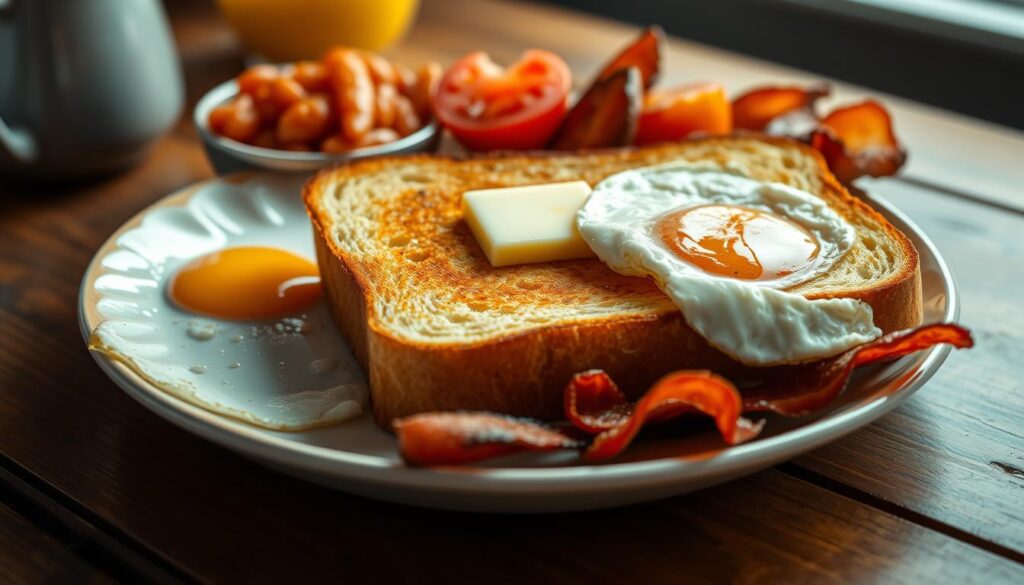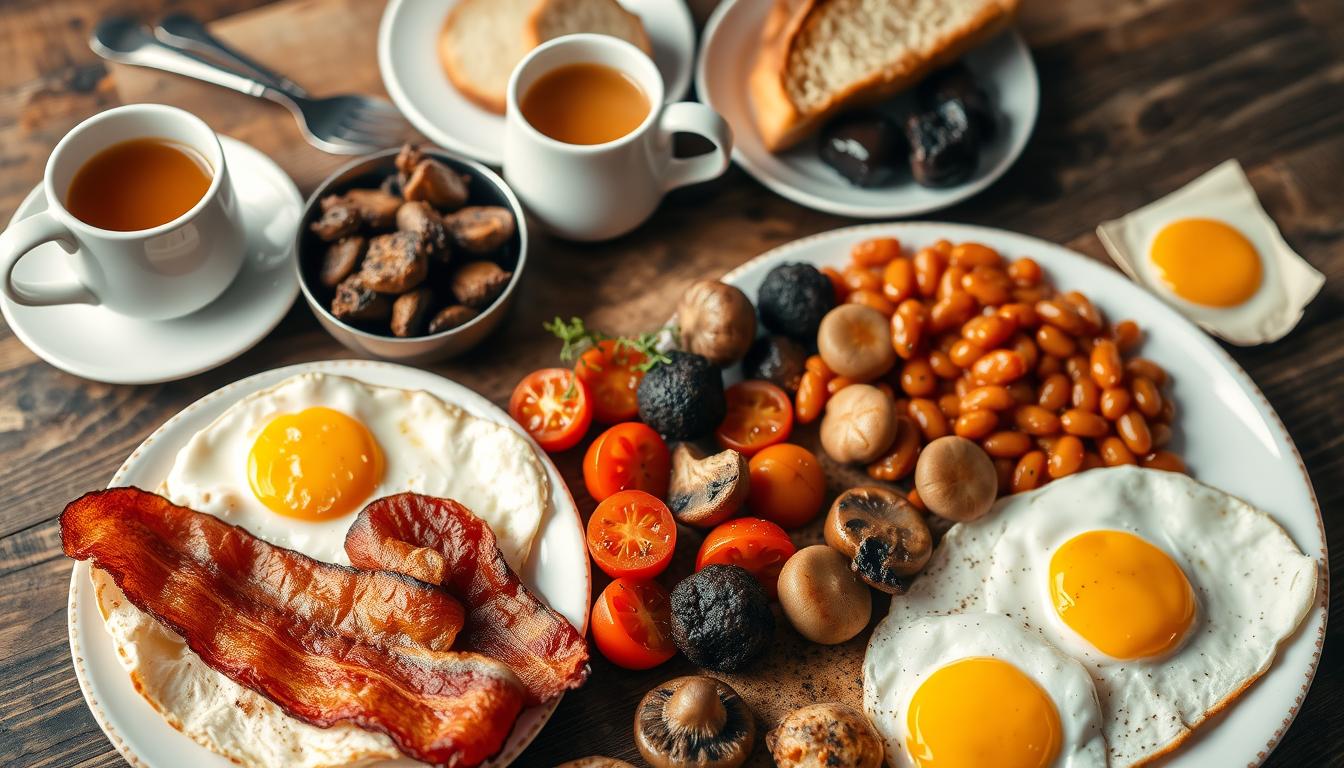Growing up, weekend mornings were sacred in my family. The sizzle of bacon, the rich aroma of brewing coffee, and the promise of a hearty meal that would fuel us through the day. That’s when I discovered the magic of the full English breakfast – a culinary tradition that transforms an ordinary morning into an extraordinary experience.
The English breakfast, or fry-up as it’s affectionately known, is more than just a meal – it’s a cultural celebration on a plate. This iconic dish brings together a symphony of flavors that will transport you straight to a cozy British kitchen. From perfectly cooked sausages to crispy back bacon, each component tells a story of traditional British cuisine.
Whether you’re a breakfast enthusiast or simply curious about international culinary traditions, this guide will walk you through creating an authentic English breakfast that will impress your family and friends. Get ready to master the art of the ultimate morning feast!
Table of Contents
What is an English Breakfast?
The traditional breakfast known as the English fry-up is more than just a meal – it’s a culinary journey through British history. Rooted in centuries of cultural evolution, the English cooked breakfast represents a hearty and iconic dining experience that has captured the hearts of food lovers worldwide.
Dating back to the Victorian era, this beloved breakfast has transformed from an exclusive gentry meal to a beloved national dish. A 2017 YouGov poll revealed fascinating insights into what makes an ideal full English breakfast:
- More than 50% include bacon, sausage, and eggs
- Baked beans and toast are considered essential components
- 35% of respondents include black pudding
- 26% add hash browns or sautéed potatoes
The Historical Roots of the Breakfast
The origins of this iconic meal stretch back to the Anglo-Saxon period, with the term morgenmete describing early morning meals. By the 12th and 13th centuries, a distinctive breakfast culture began to emerge in English society.
“The full English breakfast is not just a meal, but a cultural institution that tells the story of British culinary heritage.”
Key Ingredients Explained
A classic English fry-up typically includes a combination of core ingredients that have remained relatively consistent over time:
| Ingredient | Popularity | Regional Variations |
|---|---|---|
| Bacon | 95% | Different cuts across regions |
| Sausages | 90% | Variations like Cumberland or Lincolnshire |
| Eggs | 85% | Fried, scrambled, or poached |
| Baked Beans | 70% | Tomato sauce based |
| Black Pudding | 35% | More popular in Northern England |
Whether you’re a food enthusiast or a curious cook, understanding the rich history and components of the English breakfast will help you appreciate this classic culinary tradition.
Essential Ingredients for an Authentic Experience
Crafting a great British breakfast requires careful selection of key ingredients. Your english morning meal isn’t just about throwing together random components – it’s an art form that celebrates traditional flavors and culinary heritage.
Sausages: The Backbone of Your Breakfast
British-style sausages, or bangers, are crucial to an authentic british breakfast. Unlike American sausages, these are typically:
- Thicker in diameter
- More coarsely ground
- Made with higher meat content
- Seasoned with traditional British spices
Bacon: Understanding Your Cuts
Forget what you know about American bacon. In a true english morning meal, back bacon reigns supreme. This cut is meatier and less fatty compared to streaky bacon, providing a richer flavor profile.
“A proper British breakfast starts with quality bacon” – Traditional British Chef
Eggs: Perfecting the Technique
For an authentic great british breakfast, sunny-side up eggs are the gold standard. The key is maintaining a runny yolk that can be mixed with other ingredients for maximum flavor.
Baked Beans: A Quintessential Component
No british breakfast is complete without Heinz baked beans. These aren’t your typical American barbecue beans – they’re a smooth, tomato-based side that adds both flavor and texture to your plate.
| Ingredient | Quantity for 2 Servings |
|---|---|
| Bacon Rashers | 4 pieces |
| Sausages | 2 pieces |
| Eggs | 2 pieces |
| Baked Beans | 1 cup |
Preparing Your Kitchen for Cooking
Creating an authentic english breakfast requires careful preparation and the right kitchen setup. Your hearty breakfast adventure begins with organizing your cooking space and gathering essential tools. A well-prepared kitchen makes cooking a full english breakfast smooth and enjoyable.
Before you start cooking, you’ll need several key pieces of equipment to ensure a successful meal:
- Large cast iron skillet or heavy-bottomed frying pan
- Multiple smaller pans for simultaneous cooking
- Spatula and tongs
- Toaster or grill pan
- Sharp cooking knife
- Cutting board
Essential Cooking Tools for Your Full English Breakfast
A large cast iron skillet is your secret weapon for preparing an authentic english breakfast. This versatile pan allows you to cook multiple ingredients simultaneously, maintaining heat distribution and creating perfect crispy textures.
“The right tools can transform a good breakfast into an extraordinary culinary experience.” – Professional Chef
Setting Up an Efficient Cooking Station
Organize your cooking area strategically. Place all ingredients within reach, have your pans preheated, and arrange your tools in a logical sequence. This preparation ensures you can manage multiple components of your hearty breakfast without stress.
Pro tip: Keep paper towels nearby for draining excess oil and have warm plates ready to serve your delicious full english breakfast immediately after cooking.
Cooking the Perfect Sausages
Sausages are a cornerstone of the traditional breakfast, and mastering their preparation is key to creating an authentic English fry-up. Whether you’re a breakfast enthusiast or a novice cook, understanding the nuances of sausage cooking will elevate your morning meal.
Temperature and Timing Tips
Cooking sausages requires precision and patience. Here are some essential tips to ensure your sausages are perfectly cooked:
- Preheat your oven to 350°F for consistent cooking
- Cook sausages 5 minutes per side for even heat distribution
- Use medium to medium-low heat to prevent burning
Achieving the Ideal Crispiness
The secret to a delectable sausage lies in achieving that perfect crispy exterior while maintaining a juicy interior. Pan-frying offers an excellent method for your english fry-up:
- Use 2 tablespoons of vegetable oil
- Cook medallions 3 minutes on the first side
- Flip and cook an additional 2 minutes
“A perfectly cooked sausage is the heart of any traditional breakfast!” – British Breakfast Enthusiasts
Pro tip: Grilling can add a smoky flavor that enhances the overall taste of your sausages, making your english breakfast truly memorable.
Mastering Bacon Cooking Techniques
Perfecting bacon is a crucial skill for creating an authentic english cooked breakfast. Whether you’re preparing a great british breakfast or exploring traditional cooking methods, understanding bacon preparation can elevate your culinary experience.
Cooking bacon requires careful attention to detail. The two primary methods for preparing bacon are stovetop and oven cooking, each with unique advantages for your british breakfast.
Stovetop vs. Oven Cooking Methods
When cooking bacon, you have two primary techniques to consider:
- Stovetop Method: Quick and direct heat control
- Oven Method: More even cooking and less hands-on management
| Cooking Method | Pros | Cons |
|---|---|---|
| Stovetop | Faster cooking | More grease splatter |
| Oven | Consistent results | Longer cooking time |
Achieving Perfect Bacon Doneness
For an ideal english cooked breakfast, consider these doneness levels:
- Soft: Slightly chewy with minimal crispiness
- Medium: Balanced between crisp edges and tender center
- Crispy: Completely crunchy throughout
“The secret to perfect bacon is patience and temperature control.”
Pro tip for your great british breakfast: Start with cold bacon in a room-temperature pan. This helps render fat more effectively and ensures even cooking.
Preparing the Eggs
The eggs are a crucial component of an authentic english morning meal. Whether you prefer fried, scrambled, or poached, mastering egg preparation will elevate your hearty breakfast to the next level. Each cooking method brings unique flavors and textures to your full english breakfast.

Fried Eggs: Achieving Perfection
Fried eggs reign supreme in the world of English breakfast, with 27% of UK adults choosing this classic preparation. To create the perfect sunny-side up egg:
- Use fresh eggs for firmer whites and vibrant yolks
- Cook over medium heat to prevent rubbery whites
- Cook for 3-4 minutes to achieve tender whites and runny yolks
Scrambled Eggs: Creamy Texture Secrets
Scrambled eggs, preferred by 22% of breakfast enthusiasts, require a delicate touch. The key to creamy scrambled eggs lies in gentle cooking and careful technique.
| Technique | Result |
|---|---|
| Low heat | Creamy, soft texture |
| Constant stirring | Prevents overcooking |
| Butter vs. Oil | Rich flavor or crispy edge |
Poached Eggs: Mastering the Technique
Poached eggs, chosen by 15% of respondents, offer a healthier alternative. Pro tip: Use fresh eggs and create a gentle whirlpool in simmering water to achieve perfect poached eggs every time.
The secret to a great egg is patience and attention to detail.
The Role of Baked Beans
Baked beans are a quintessential component of the traditional English breakfast. These tomato-based legumes bring a unique flavor and texture to the classic English fry-up that most people can’t imagine skipping. Unlike American-style baked beans, British baked beans have a distinct character that sets them apart.
Choosing the Right Brand for Your English Breakfast
When selecting baked beans for an authentic English breakfast, Heinz remains the gold standard. Here are some key considerations:
- Look for British-style beans in tomato sauce
- Avoid American-style sweet or barbecue beans
- Prioritize canned beans for traditional preparation
Homemade Baked Beans Recipe
If you’re feeling adventurous, making your own baked beans can elevate your traditional breakfast experience. The process might seem daunting, but it’s quite straightforward.
“Homemade baked beans can transform your English breakfast from good to extraordinary!” – British Breakfast Enthusiasts
Basic ingredients for homemade baked beans include:
- Dried navy beans
- Tomato paste
- Worcestershire sauce
- Sugar
- Salt and pepper
A typical homemade batch yields about 2 quarts and takes approximately 6-8 hours in a slow cooker. Each serving contains around 89 calories and provides a hearty protein boost to your English breakfast.
Whether you choose store-bought or homemade, baked beans are an essential element that brings authenticity to your traditional English breakfast experience.
Adding Tomatoes and Mushrooms
Every great british breakfast needs vibrant vegetables to complete the perfect fry-up. Tomatoes and mushrooms are essential components that bring color, flavor, and nutrition to your english cooked breakfast.
Selecting and Preparing Tomatoes
When choosing tomatoes for your breakfast, opt for ripe, firm varieties that can withstand high-heat cooking. Roma or vine-ripened tomatoes work best for a traditional approach.
- Slice tomatoes in half
- Season with salt and pepper
- Cook in the same pan as your other ingredients
Mastering Mushroom Techniques
Mushrooms add an earthy depth to your breakfast. Select fresh, firm mushrooms like button or cremini for the best results.
| Mushroom Type | Preparation Method | Cooking Time |
|---|---|---|
| Button Mushrooms | Sliced | 3-4 minutes |
| Cremini | Quartered | 4-5 minutes |
| Portobello | Thick slices | 5-6 minutes |
Sauté mushrooms in butter or olive oil until they develop a golden-brown color and release their natural moisture.
“The secret to perfect mushrooms is patience and high heat” – British Breakfast Chef
By carefully preparing your tomatoes and mushrooms, you’ll elevate your english cooked breakfast from good to extraordinary.
Toast: The Perfect Complement
Every british breakfast deserves a perfect slice of toast to complete the hearty morning meal. The bread component plays a crucial role in creating an authentic english morning meal that satisfies and energizes you for the day ahead.

When preparing your toast for a traditional english morning meal, you have several delicious options to consider:
- White bread: Classic and traditional choice
- Wholemeal bread: Healthier alternative with more nutrients
- Sourdough: Adds a unique tangy flavor
- Rye bread: Provides a denser texture
Bread Selection Tips
Selecting the right bread can elevate your british breakfast experience. Thickness matters – aim for slices around 1/2 inch thick to ensure proper toasting and a satisfying bite.
Achieving Golden Toast Perfection
To create the ideal toast for your hearty breakfast, follow these expert techniques:
- Choose a reliable toaster with adjustable settings
- Set the toaster to medium-high for a golden-brown color
- Watch carefully to prevent burning
- Butter immediately after toasting for maximum flavor
“A perfectly toasted slice of bread can transform an ordinary breakfast into an extraordinary culinary experience.” – British Breakfast Enthusiast
Pro tip: If you prefer a traditional approach, try lightly frying your bread in a pan with a touch of butter for an extra crispy texture that complements your full english breakfast.
Bringing It All Together
Creating an authentic full english breakfast is an art form that goes beyond simply cooking ingredients. The final presentation transforms a collection of delicious components into a memorable culinary experience.
When plating your traditional breakfast, follow these strategic guidelines to achieve an authentic look:
- Place baked beans in the center of the plate
- Position bacon at the 1-2 o’clock location
- Arrange sausages at the 3 o’clock position
- Place eggs at the 6 o’clock spot
- Fill remaining spaces with vegetables
Garnishing Your English Breakfast
The right garnishes can elevate your english breakfast from good to extraordinary. Consider these finishing touches:
- Sprinkle fresh parsley for color
- Add a pat of butter on toast
- Dust with cracked black pepper
- Drizzle a small amount of HP Sauce
Final Presentation Tips
A well-presented full english breakfast is about creating visual appeal. Use white plates to make colors pop and ensure each component has breathing room. Your goal is to make the plate look inviting yet not overcrowded.
“Breakfast is everything. The beginning, the first thing. It is the mouthful that is the commitment to a new day, a continuing life.” – A.A. Gill
| Component | Recommended Placement | Visual Impact |
|---|---|---|
| Baked Beans | Center | Creates focal point |
| Bacon | 1-2 o’clock | Adds crisp texture |
| Sausages | 3 o’clock | Provides volume |
| Eggs | 6 o’clock | Highlights protein |
Remember, your english breakfast is not just a meal—it’s a culinary tradition waiting to be celebrated on your plate!
Serving Suggestions and Pairings
Completing your english fry-up is all about the perfect accompaniments that elevate the great british breakfast experience. The right drinks and condiments can transform an ordinary meal into a memorable culinary journey.
Beverage Choices for Your English Cooked Breakfast
Traditionalists know that tea reigns supreme in a classic english breakfast. Here are the top beverage pairings:
- Traditional English Breakfast Tea
- Strong Black Coffee
- Fresh Orange Juice
- Herbal Tea Alternatives
Ideal Condiments and Accompaniments
No english fry-up is complete without the right sauces and sides. Consider these flavor enhancers:
- HP Brown Sauce
- Tomato Ketchup
- Butter for Toast
- Marmalade or Jam
“A perfect breakfast is about balance – between flavors, textures, and traditions.”
Your beverage should complement the rich, savory elements of the breakfast. English breakfast tea offers a robust flavor that cuts through the richness of bacon and sausages, while coffee provides a bold alternative for those seeking a different morning ritual.
Pro Tips for Serving
- Serve tea or coffee piping hot
- Offer condiments on the side
- Warm your plates before serving
- Consider individual preferences
Experiment with these suggestions to create a personalized great british breakfast that delights your taste buds and honors traditional culinary techniques.
Tips for Customizing Your English Breakfast
Transforming your traditional British breakfast into a personalized morning meal opens up exciting culinary possibilities. Whether you’re looking to accommodate dietary restrictions or explore regional variations, your english morning meal can be adapted to suit your unique taste preferences and nutritional needs.
Vegetarian and Vegan Alternatives
For those seeking plant-based options, your hearty breakfast can still deliver delicious flavors. Vegetarian sausages made from soy or plant proteins can replace traditional meat links. Tempeh bacon provides a smoky alternative to back bacon, while scrambled tofu seasoned with turmeric offers a protein-packed egg substitute that maintains the classic british breakfast experience.
Region-Specific Twists to Consider
Exploring regional variations can add authentic charm to your english morning meal. Scottish breakfast enthusiasts might include potato scones, while Welsh variations could incorporate laverbread. Each region brings unique ingredients that transform the standard Full English breakfast into a personalized culinary journey that reflects local traditions and flavors.
Your creativity is the key to crafting a breakfast that honors tradition while meeting your individual dietary preferences. By experimenting with ingredients and techniques, you can develop a british breakfast that is both authentic and uniquely yours.

